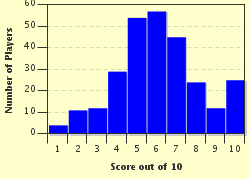Quiz Answer Key and Fun Facts
1. Army basic training in the 1960s was offered (for lack of a better word) at which army post.
2. How long were the Vietnam Era Basic Training programs (also known as boot camp)?
3. The first thing a recruit would hear on his first morning (and thereafter) was a bugle call. What is the daily order for the four main calls?
4. A recruit was to call the training sergeant or drill sergeant "Sir."
5. Since smoking was allowed in this time period, checking "butt cans" was part of the duty. Old wooden barracks and coal heat meant for all-night watches to be mounted by what?
6. Physical training, or PT, began on the second day of Basic Training and never stopped. One's progress in this effort was measured at the end of the eight weeks by a PT Test. Which of these was not a part of the test?
7. Overnight stays in the "field" were common near the end of training. What is the Army term for such exercises?
8. Field excercises were also considered a good time to introduce trainees to the culinary masterpieces known as "Meals, Combat, Individual" or C Rations, the sucessor to WWII K Rations. Which of these was the least sought after of the main meal choices?
9. Oh, what different days! Included with each C Ration box were various cookies, cakes and fruit (called "B" Units) and an Accessory Pack with toilet paper, salt and pepper, matches, etc. and a little pack with typically how many cigarettes?
10. "Sir, Private Jones reporting for pay!" was a monthly ritual, attended by various attempts to separate the trainee from a part of his or her hard-earned pay for such things as Savings Bonds. Pay was in the form of what?
Source: Author
scalar
This quiz was reviewed by FunTrivia editor
trident before going online.
Any errors found in FunTrivia content are routinely corrected through our feedback system.

